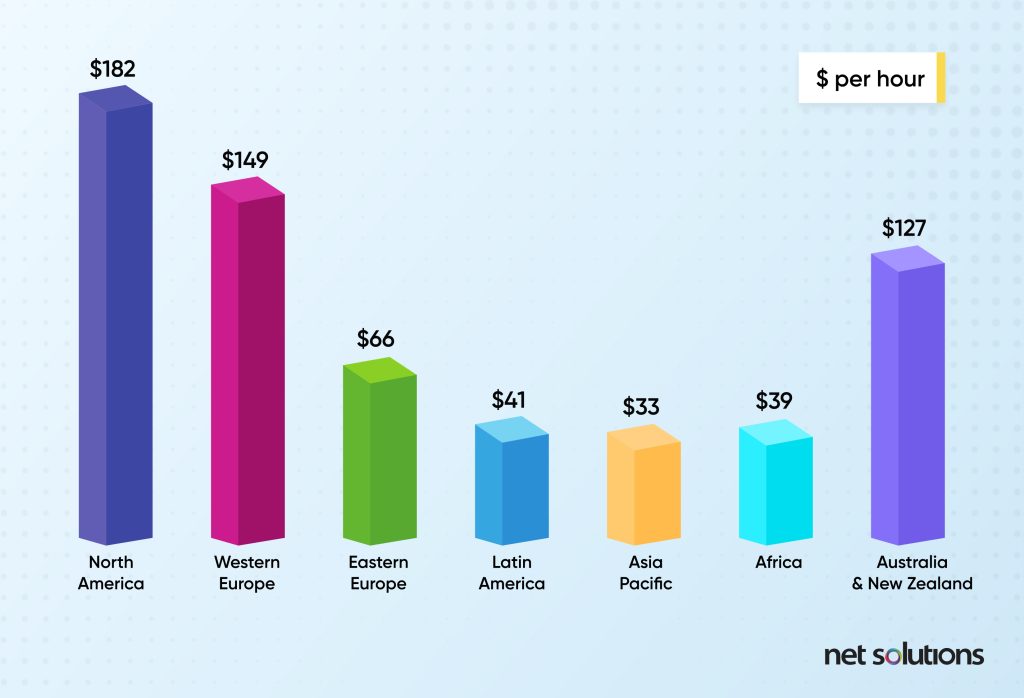Software development outsourcing comes with a whole host of potential benefits, from cost savings to greater efficiency, but it’s important to make an informed decision about whether outsourcing is right for you.
This guide provides a general outline of what you need to know before searching for an outsourcing vendor—from benefits to potential challenges—along with many important factors to consider.
We’ll also explore different software outsourcing models so you can build the ideal strategy for your organization, and we provide links to more in-depth discussions on each topic.
What is Software Development Outsourcing?
Software development outsourcing is the act of hiring an outside development team to handle some or all of a software development project. An outsourcing partner may consist of an onshore team that works in your country or an offshore team on the opposite side of the world.
Full-service outsourcing teams can handle design, software development, Quality Assurance (QA) testing, and project management—overseeing the entire development process from start to finish if that’s what their customers require.
Of course, an outsourcing project may also involve working with specialists in any of these areas to supplement an in-house development team’s work. It all depends on the project requirements.
This guide will outline everything you need to know about outsourcing, with plenty of links to resources where you can dive deep into the outsourcing topics most relevant to your business needs.
Chapter 1Outsourcing Software Development Pros and Cons
If you’re considering working with an outside software development team, it’s important to understand the benefits and risks. Here are a few of the pros and cons of outsourcing software development.
Pros for outsourcing software development include:
- Cost-effective services: Outsourcing typically comes with powerful cost savings compared to hiring an in-house team, since regular employees come with hidden costs and offshore rates are competitive.
- Access to a worldwide talent pool: Draw expertise from tech talent across the globe.
- Flexibility and scalability: Unlike regular employees, you only have to pay outsourced talent when there’s work to be done, making it easy to grow and scale.
Cons for outsourcing software development include:
- Cultural and language barriers: Communication can be challenging when working with some offshore teams, so carefully vet prospective partners to assess their communication skills.
- Lack of technical expertise: While there are many talented outsourcing partners, be sure to read customer reviews on sites like Clutch.co, and ask for testimonials and case studies.
- Security risks: Partners can gain access to vital data, so make sure any potential partner has a proven track record of integrity and follows the latest cyber security protocols.
Outsourcing can be a flexible, cost-effective solution when you properly manage the risks and perform your due diligence.
Chapter 2Benefits of Outsourcing Software Development
Companies that take a strategic approach to finding a tech partner enjoy the many benefits of outsourcing software development. Here are some of the most powerful benefits.
- Cost savings: Thanks to reduced overhead, lower labor costs, and the fact that companies don’t need to pay benefits or payroll taxes for outsourcing services, this approach can deliver powerful returns.
- Staff augmentation: In-house developers are usually hired for their specific skill sets. Software outsourcing services can connect you to a wide range of professionals to fill any skills gap.
- Efficiency: Outsourcing partners can help you become more efficient, taking over tasks while your team handles what they do best.
- Faster time-to-market: Time is of the essence with new software products and releases, and a talented team can help you beat your competitors to the punch.
- Supporting business growth: Thanks to the flexibility of working with an outsourcing partner, you can scale at a pace that makes sense and grow without worrying about bottlenecks in productivity.
Working with a software development partner that takes a DevOps approach and is well-versed in Agile development can help you take full advantage of outsourcing’s benefits.
Chapter 3Software Outsourcing Challenges
While an effective solution for most companies, there are some potential software outsourcing challenges that any company considering working with an outside service provider should consider. Here are some common risks and how you can avoid them.
Communication challenges: Any time you work with an outside partner on any project, there’s the potential for miscommunication. You can mitigate this risk by ensuring your partner has clear processes in place to communicate their progress at every step.
Runaway budgets: While outsourcing tends to be cost-effective, an inexperienced team that isn’t strategic about its development process may go over budget. Ask about a prospective partner’s processes and how they reduce the risk of rework.
Time zone difference: When hiring a partner in a distant time zone, working asynchronously might not be an option. If that’s the case, be sure to find a partner who will adapt to your work hours.
Careful vetting, clear communication, and setting expectations is key to a successful outsourcing strategy, and it will help you avoid many pitfalls.
Chapter 4Software Development Outsourcing Trends
This is an exciting time for software engineering, and leading outsourcing firms are up on the latest trends associated with digital transformation and cloud computing. Here are some of the software development outsourcing trends reshaping countless industries.
Hybrid development models: Thanks to cloud computing and instant communications across the globe, many companies are adopting a hybrid model of development where they use their in-house team to address their core business needs and a dedicated team at a partner company to handle other elements.
DevOps and Agile methodologies: While these methodologies are nothing new in the software world, what makes this a noteworthy trend is that many companies now work exclusively with outsourcing partners who use this approach.
AI and Robotic Process Automation (RPA): Cutting-edge outsourcing firms often hire experts in AI and RPA to support digital transformation efforts. Be sure to work with a team that has experience in these areas if you’re considering implementing them into your current systems.
Advanced Analytics: Another key component of digital transformation and cloud computing is advanced analytics, which can provide powerful customer insights thanks to the elimination of data silos common to outmoded systems.
Even legacy retail brands are engaging in digital transformation. Retailers like Walmart, IKEA, and Home Depot are embracing these trends to gain more market share and stay ahead of their online retail competitors.
Chapter 5Software Development Outsourcing Statistics
The outsourcing market has been on the rise for years, and it shows no signs of slowing. Here are some software development outsourcing statistics that demonstrate the rise in outsourcing and the rationale behind hiring outside teams for app development, digital transformation, and other IT-related projects.
- Outsourcing is expected to grow by 70% this year, and the total market is expected to reach $118.7 billion before the end of the year
- Companies in the United States are the largest outsourcing customers, and the sector shows a growth rate of 1.82% per year
- By 2028, U.S. companies are expected to reach $129.9 billion in annual expenditures
- 42% of Chief Technical Officers (CTOs) site the need for rapid scaling as a key driver behind the decision to outsource
Of course, none of these statistics suggest that these companies are willing to sacrifice quality for the scaling capabilities and cost savings that come with outsourcing.
In fact, 56% of CTOs listed “quality of work” as their primary concern when it comes to outsourcing, underscoring the importance of carefully vetting any potential onshore, nearshore, and offshore software development partners.
Chapter 6 Software Development Outsourcing Models
There are several different approaches you can take to outsourcing. Here is a brief description of the three main software development outsourcing models.
Full outsourcing: Full outsourcing means handing over every element of your development needs to an outsourcing team, from design and project management to QA and deployment.
This model is great for those who don’t want to hire an in-house team, but you’ll need to work with a firm that understands the value of communication and solicits regular feedback.
Selective outsourcing: Selective outsourcing means handing over specific tasks to an outsourcing partner, such as testing, to supplement your in-house team’s work.
This gives you greater control over the process, allowing your in-house team to focus on their core competencies. Keep in mind, however, that it might not come at a lower cost overall, since in-house employees usually come with a higher price tag.
Hybrid outsourcing: As the name implies, hybrid outsourcing combines both models. It involves developing clear communication between both teams, and the dedicated team at the outsourcing company often becomes an extension of your own team.
Whichever model you choose to adopt, the same principles apply to selecting a partner. Choose someone with a proven track record and strong communication skills.
Chapter 7How Much Does It Cost to Outsource Software Development?
Software development teams exist around the world, and hourly rates for software development vary greatly from one country to the next.
Since many of our prospective clients are curious about worldwide rates, we’ve created a comprehensive guide outlining how much it costs to outsource software development across the globe.
Naturally, it costs significantly more to outsource software development to the United States or Germany than it does to outsource to countries like India or Argentina due to cost-of-living differences. This makes offshoring a great way to reduce development costs, assuming you carefully vet your prospective vendors.
Here is a glimpse at prices for different regions, but keep in mind that there is a great deal of variation from one country to the next. We compiled these figures from data collected on websites like PayScale, SalaryExpert, and Indeed.

North America: $182 per hour
Western Europe: $149 per hour
Eastern Europe: $66 per hour
Latin America: $41 per hour
Asia Pacific: $33 per hour
Africa: $39 per hour
Australia and New Zealand: $127 per hour
Keep in mind that you will find plenty of individual variation from one provider to the next, and price shouldn’t be your only consideration. Again, take a look at our country-by-country cost guide for more detailed data.
Chapter 8Questions to Ask When Outsourcing Software Development
Hiring the right partner is key to producing high-quality software products, and that makes the vetting process an extremely important step. What are some of the most important questions to ask when outsourcing software development?
Here are some good questions that will help you determine whether a potential partner is right for you.
- What software development methodologies do you use?
- Who is responsible for project management on your team?
- What is your process for gathering feedback from us, and how often do you check in? Is it on a regular basis, or just when you hit certain milestones?
- Which methodologies do you use in your development process? Are you an Agile team?
- Which cybersecurity protocols do you follow and how will you protect our data from bad actors?
- What experience do you have with the type of development project we need help with (e.g., mobile app development, app modernization)?
- Which services do you provide beyond software development, such as general design, User Experience (UX) design, testing, security, etc.?
These questions should get you started, but again, be sure to review our more comprehensive guide for a larger list of questions and the rationale behind asking them.
Chapter 9Outsourcing Software Development for Startups
We often think of large companies engaging in IT outsourcing, and while we’ve worked with many enterprise clients, we’ve also worked with countless startups here at Net Solutions.
What are some of the benefits of outsourcing software development for startups?
- Scalability: Startups often turn to outsourcing partners to help them grow at a rapid pace. This can help them receive additional funding and earn revenue that helps them stay ahead of their burn rate.
- Flexibility: Startups can see tremendous variability when they launch a new product, and hiring additional full-time staff while scaling can be costly if funds dry up or business drops. Intelligent outsourcing eliminates those concerns.
- Technical guidance (for non-technical founders): Non-technical founders often rely on outsourcing partners to build their Minimum Viable Product (MVP) while the founders themselves provide the vision and build the business strategy.
- Technical expertise (for technical founders): Even technical founders who are full-stack engineers won’t have deeply honed expertise in every aspect of application development. Working with an outsourcing partner allows the technical founder to focus on what they do best.
Startups may choose to hire internal development staff down the line, once they start turning a profit—or they may stick to outsourcing their software development to the team that delivered the initial product. Either way, outsourcing gives them plenty of options.
Chapter 10Software Development Outsourcing Companies
Are you looking for a full-service outsourcing partner? Here are a few software development outsourcing companies worth considering.
Net Solutions: Full disclosure—that’s us—but we’re confident we can compete with other top providers, given our 20+ year track record and top reviews on sites like Clutch.co.
We have a vast library of case studies that demonstrate our expertise, and our English fluency is a strong selling point for our U.S. and European clients.
Arcanys: A Swiss software development firm (located in the Philippines) with 20+ years of experience, they’ve got the longevity and expertise to handle product development for a range of businesses.
Yes, they’re a competitor of ours, but we consider them a worthy opponent, and we admire their work.
ScienceSoft: Another worthy competitor, ScienceSoft is a U.S. company with offices in various locations around the world. They’ve worked with big names and they have solid reviews.
Do note that, while both Arcanys and ScienceSoft are Western companies, their developers are located in other countries. That helps reduce costs, but be sure to vet their actual developers and project managers for language and cultural fluency, just as you would any offshore outsourcing firm.
Chapter 11Onshoring, Nearshoring, and Offshoring
Another big question to consider is whether to work with partners within your own country, in a nearby country, or someone in a far-flung destination overseas.
Onshoring: Onshoring means outsourcing to a software development firm within your own country, such as a company in Los Angeles outsourcing their development to a team in Ohio.
This provides some cost savings since you won’t have to deal with the hidden costs of hiring in-house employees that we referenced above, but it won’t provide nearly the same savings as outsourcing abroad. One clear advantage, however, is that it eliminates the risk of language and cultural barriers.
Nearshoring: Nearshoring means outsourcing work to a software development firm in a nearby country, such as a U.S. firm outsourcing to Mexico or Canada. This can produce significant cost savings depending on where you outsource—Mexico would obviously be less expensive than Canada. It also has the advantage of working within similar time zones.
Offshoring: Offshoring involves outsourcing overseas, to either a different continent or even the opposite side of the world. This can produce significant savings, especially for those outsourcing to countries like the Philippines or India.
When offshoring or nearshoring, be sure to thoroughly vet potential partners to ensure they speak your operating language well and that there are no insurmountable cultural differences that might impact communication and cooperation.
Chapter 12Software Development Outsourcing in India
Custom software development in India has become very popular in recent years. Even though we’re an Indian firm, we want to give our readers a realistic look at both the benefits and challenges of working with Indian companies.
The benefits of outsourcing to India include:
Value: Hourly rates for developers are highly competitive in India, so you can get high-quality work for very reasonable rates.
Wide talent pool: The world’s most populous country is packed with sharp, young, talented software professionals. Coursera’s Global Skills Report notes that Indian engineers excel in the latest technologies, including cloud computing.
High level of English fluency: India has 200+ million English speakers, and English fluency is common among educated professionals.
Time zone advantage: Indian development firms can work while North American teams sleep, enabling round-the-clock production. If you want them to adapt to your hours, some firms (like Net Solutions) can accommodate that as well.
Of course, there can be some challenges associated with outsourcing to India. For example, not all firms are willing to adapt to client hours, and some won’t have your desired level of fluency.
All this underscores the importance of asking the right questions and thoroughly vetting any prospective outsourcing partners.
In Need of a Software Development Partner?
Net Solutions has been providing software development services, and building software solutions for startups and enterprises, for over 30 years. We’ve worked with many leading companies like IMG, along with world-renowned institutions like the Harvard Business Review.
If you’re looking to outsource all or part of your software development needs, schedule a call today to discuss your project needs, project scope, deliverables, and how we can help.
SHARE THIS POST
Table of Contents
Related Resources
- 10 Key Benefits of Outsourcing Software Development
- 10 Common Software Outsourcing Challenges [With Solutions]
- 19 Best Software Development Outsourcing Companies in 2024
- How Much Does It Cost to Outsource Software Development?
- Software Development Outsourcing: India's Top 11 Contenders
- Comparing Software Development Outsourcing Models: A Decision-Maker's Guide
- A Guide to Nearshore Software Development Outsourcing [2024]
- Outsourcing Software Development: Evaluating the Pros and Cons
- 15 Questions to Ask when Outsourcing Software Development
- Outsourcing Software Development for Startups [2024 Guide]
- 2024 Software Development Outsourcing Statistics: Trends, Insights & Predictions
- Software Development Outsourcing Trends

